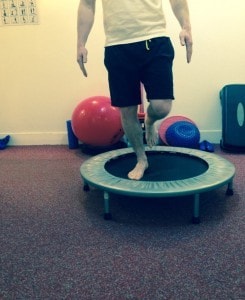What Are Ligaments?
A ligaments is a taut bands of dense, fibrous connective tissue, which joins two bones or layers of cartilage. Due to its position between these two bones, and hence over the joint they create, the ligament serves as a prime passive stabiliser of the involved joint, facilitating normal movement while also preventing excessive amounts of this movement.
How Do Ligaments Work?
Ligaments are somewhat flexible, hence they allow for a certain amount of above-normal movement of a joint. Once this movement threatens to continue to the point of possible injury however, movement is restricted by the dense, taut nature of the ligament. This restriction is the prime function of the ligament – to prevent an amount of joint movement which may induce injury.
How Does The Ligament Itself Get Injured?
While ligaments do provide considerable resistance to movement due to their make-up of dense tissue, it is possible to move through this resistance and ultimately either strain or tear the ligament in question. Such excessive load is typically placed on a ligament via an event of considerable trauma. A ligament injury can be classified as Grade 1 (strain, but no tearing of the ligament), Grade 2 (strain, with some tearing), or Grade 3 (complete tearing of the ligament where two ends separate). Occasionally, a ligament injury can occur whereby one end of the ligament is actually torn off the bone to which it usually attaches.
Ligament injuries are commonly seen in contact sports, falls from mountain bikes, road traffic accidents etc. Such is the case, as the inertia of the high intensity impact exceeds the load the ligament is capable of absorbing naturally, resulting in injury.
What Areas Are Most Commonly Affected With This Condition?
At K.M. Woods Physiotherapy, several joints are typically most implicated when ligament injuries are concerned. Ankle inversion injuries, where the ankle rolls inwards hence straining the ligaments as the outside of the ankle, are very common, especially in football and basketball. Knee ligament injuries are common also, again often during sporting pursuits, be it the MCL or LCL, or the more serious ACL (Anterior Cruciate Ligament). Falls over handlebars of bikes, or attempting to break a fall by placing the hand out in front, will occasionally lead to ligament injuries to the shoulder or collar bone.
How Do Ligament Injuries Present?
Typically, the patient can identify the specific trauma or incident which caused the injury initially, and this can prove a huge help to the physiotherapist in diagnosing a ligament injury. Ligament injuries typically present with localised pain about the area of the implicated ligament, with adjacent swelling also notable. Symptoms will usually be exacerbated when a particular movement is undertaken which stresses the injured ligament, such as twisting of the knee in knee ligament injuries, or walking over uneven ground in ankle ligament injuries. Instability can also be reported in the implicated joint or body part, as the usually solid ligament fails to support even normal movement.
How Can Physiotherapy Help
Many physiotherapy treatments have been shown to be successful in their treatment of ligament injuries. Treatment is tailored to suit the individual patient, following a thorough assessment. Treatment may include
- Transverse friction massage
- Taping
- Proprioceptive exercise-focused rehabilitation
- Joint mobilization with movement (MWM)
- Strengthening of localised muscles to help alleviate the burden of stability placed on the injured ligament
- Advice on activity modification, whereby loading of the injured ligament is required to promote healing and alignment of scar tissue, but must not be excessive or premature.
What Can I Do To Help This Condition Myself?
Prior to, or while attending physiotherapy, the patient can also help the recovery process by following several steps
- If still within the first 72 hours post-injury, ice therapy is advised to limit swelling and control pain. Thereafter, heat therapy is advised to encourage blood flow, which increase the rate of healing.
- Continue to undertake activities as normal, but nor to the point where pain levels are acutely increased. Essentially, avoid undertaking which place excessive or sustained load on the ligament, thereby maintaining aggravation and inhibiting healing.
- Undertake gentle “self frictions” over the ligament, to encourage realignment of scar tissue and encourage healing. The ankle should also be kept mobile, to prevent stiffening of the ligament & joint secondary to inflammation.

